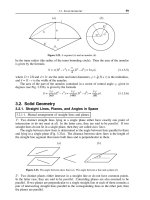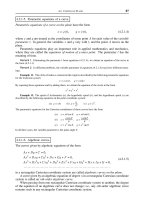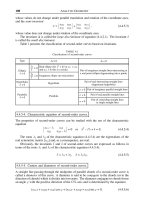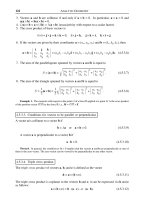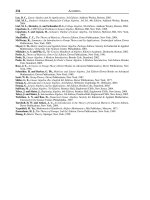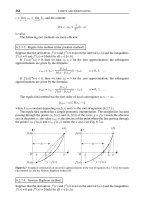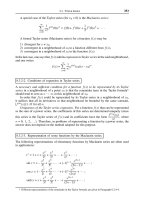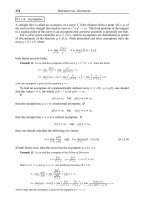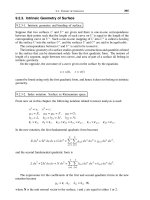Handbook of mathematics for engineers and scienteists part 210 ppt
Bạn đang xem bản rút gọn của tài liệu. Xem và tải ngay bản đầy đủ của tài liệu tại đây (369.75 KB, 7 trang )
T12.2. NONLINEAR FUNCTIONAL EQUATIONS IN ONE INDEPENDENT VARIABLE 1431
T12.2.1-3. Functional equations involving y(x)andy(ax).
10. y(2x) – ay
2
(x) =0.
A special case of equation T12.2.3.3.
Particular solution:
y(x)=
1
a
e
Cx
,
where C is an arbitrary constant.
11. y(2x) –2y
2
(x) + a =0.
A special case of equation T12.2.3.3.
Particular solutions with a = 1:
y(x)=0, y(x)=cos(Cx), y(x)=cosh(Cx),
where C is an arbitrary constant.
12. y(x)y(ax) = f(x).
A special case of equation T12.2.3.3.
T12.2.1-4. Functional equations involving y(x)andy(a/x).
13. y(x)y(a/x) = b
2
.
Solution:
y(x)=
b exp
Φ(x, a/x)
,
where Φ(x, z)=–Φ(z, x) is any antisymmetric function with two arguments.
On setting Φ(x, z)=C(ln x –lnz), one arrives at particular solutions of the form
y =
ba
–C
x
2C
,
where C is an arbitrary constant.
14. y(x)y(a/x) = f
2
(x).
The function f(x) must satisfy the condition f(x)=
f(a/x). For definiteness, we take
f(x)=f (a/x).
Solution:
y(x)=
f(x)exp
Φ(x, a/x)
,
where Φ(x, z)=–Φ(z, x) is any antisymmetric function with two arguments.
On setting Φ(x, z)=C(ln x –lnz), one arrives at particular solutions of the form
y =
a
–C
x
2C
f(x),
where C is an arbitrary constant.
15. y
2
(x) + Ay(x)y(a/x) + By
2
(a/x) + Cy(x) + Dy(a/x) = f(x).
A special case of equation T12.2.3.4.
Solution in parametric form (w is a parameter):
y
2
+ Ayw + Bw
2
+ Cy + Dw = f (x),
w
2
+ Ayw + By
2
+ Cw + Dy = f (a/x).
Eliminating w gives the solutions in implicit form.
1432 FUNCTIONAL EQUATIONS
T12.2.1-5. Other functional equations with quadratic nonlinearity.
16. y(x
2
) – ay
2
(x) =0.
Solution:
y(x)=
1
a
x
C
,
where C is an arbitrary constant. In addition, y(x) ≡ 0 is also a continuous solution.
17. y(x)y(x
a
) = f(x), a >0.
A special case of equation T12.2.3.8.
18. y(x)y
a – x
1+bx
= A
2
.
Solutions:
y(x)=
A exp
Φ
x,
a – x
1 + bx
,
where Φ(x, z)=–Φ(z, x) is any antisymmetric function with two arguments.
19. y(x)y
a – x
1+bx
= f
2
(x).
The right-hand side function must satisfy the condition f(x)=
f
a – x
1 + bx
. For definite-
ness, we take f(x)=f
a – x
1 + bx
.
Solutions:
y(x)=
f(x)exp
Φ
x,
a – x
1 + bx
,
where Φ(x, z)=–Φ(z, x) is any antisymmetric function with two arguments.
20. y
2
(x) + Ay(x)y
a – x
1+bx
+ By(x) = f(x).
A special case of equation T12.2.3.5.
21. y(x)y
a
2
– x
2
= b
2
, 0 ≤ x ≤ a.
Solutions:
y(x)=
b exp
Φ
x,
a
2
– x
2
,
where Φ(x, z)=–Φ(z, x) is any antisymmetric function with two arguments.
22. y(x)y
a
2
– x
2
= f
2
(x), 0 ≤ x ≤ a.
The right-hand side function must satisfy the condition f(x)=
f
√
a
2
– x
2
. For defi-
niteness, we take f(x)=f
√
a
2
– x
2
.
Solutions:
y(x)=
f(x)exp
Φ
x,
a
2
– x
2
,
where Φ(x, z)=–Φ(z, x) is any antisymmetric function with two arguments.
T12.2. NONLINEAR FUNCTIONAL EQUATIONS IN ONE INDEPENDENT VARIABLE 1433
23. y(sin x)y(cos x) = a
2
.
Solutions in implicit form:
y(sin x)=
a exp
Φ(sin x,cosx)
,
where Φ(x, z)=–Φ(z, x) is any antisymmetric function with two arguments.
24. y(sin x)y(cos x) = f
2
(x).
The right-hand side function must satisfy the condition f(x)=
f
π
2
–x
. For definiteness,
we take f(x)=f
π
2
– x
.
Solutions in implicit form:
y(sin x)=
f(x)exp
Φ(sin x,cosx)
,
where Φ(x, z)=–Φ(z, x) is any antisymmetric function with two arguments.
25. y(x)y
ω(x)
= b
2
, where ω
ω(x)
= x.
Solutions:
y(x)=
b exp
Φ
x, ω(x)
,
where Φ(x, z)=–Φ(z, x) is any antisymmetric function with two arguments.
26. y(x)y
ω(x)
= f
2
(x), where ω
ω(x)
= x.
The right-hand side function must satisfy the condition f (x)=
f
ω(x)
. For definiteness,
we take f(x)=f
ω(x)
.
Solutions:
y(x)=
f(x)exp
Φ
x, ω(x)
,
where Φ(x, z)=–Φ(z, x) is any antisymmetric function with two arguments.
T12.2.2. Functional Equations with Power Nonlinearity
1. y(x + a) – by
λ
(x) = f(x).
A special case of equation T12.2.3.1.
2. y
λ
(x)y(a – x) = f(x).
A special case of equation T12.2.3.2.
Solution:
y(x)=
f(x)
–
λ
1–λ
2
f(a – x)
1
1–λ
2
.
3. y
2n+1
(x) + y
2n+1
(a – x) = b, n =1, 2,
The change of variable w(x)=y
2n+1
(x) leads to a linear equation of the form T12.1.1.22:
w(x)+w(a – x)=b.
1434 FUNCTIONAL EQUATIONS
4. y(ax) = by
k
(x).
Solution for x > 0, a > 0, b > 0,andk > 0 (a ≠ 1):
y(x)=b
1
1–k
exp
x
ln k
ln a
Θ
ln x
ln a
,
where Θ(x)=Θ(x + 1) is an arbitrary periodic function with period 1.
5. y
λ
(x)y(a/x) = f(x).
A special case of equation T12.2.3.4.
Solution:
y(x)=
f(x)
–
λ
1–λ
2
f(a/x)
1
1–λ
2
.
6. y
λ
(x)y
a – x
1+bx
= f(x).
A special case of equation T12.2.3.5.
7. y
λ
(x)y
ax – β
x + b
= f(x), β = a
2
+ ab + b
2
.
A special case of equation T12.2.3.13.
8. y
λ
(x)y
bx + β
a – x
= f(x), β = a
2
+ ab + b
2
.
A special case of equation T12.2.3.13.
9. y
λ
(x)y(x
a
) = f(x).
A special case of equation T12.2.3.8.
10. y
λ
(x)y
a
2
– x
2
= f(x).
A special case of equation T12.2.3.9.
11. y
λ
(sin x)y(cos x) = f(x).
A special case of equation T12.2.3.10.
T12.2.3. Nonlinear Functional Equation of General Form
1. F
x, y(x), y(x + a)
=0.
We assume that a > 0. Let us solve the equation for y(x + a) to obtain
y(x + a)=f
x, y(x)
.(1)
1
◦
. First, let us assume that the equation is defined on a discrete set of points x = x
0
+ ak
with integer k. Given an initial value y(x
0
), one can make use of (1) to find sequentially
y(x
0
+ a), y(x
0
+ 2a), etc.
Solving the original equation for y(x) yields
y(x)=g
x, y(x + a)
.(2)
On setting x = x
0
– a here, one can find y(x
0
– a) and then likewise y(x
0
– 2a)etc.
Thus, given initial data, one can use the equation to find y(x) at all points x
0
+ak,where
k = 0, 1, 2,
T12.2. NONLINEAR FUNCTIONAL EQUATIONS IN ONE INDEPENDENT VARIABLE 1435
2
◦
. Now assume that x in the equation can vary continuously. Also assume that y(x)isa
continuous function defined arbitrarily on the semi-interval [0, a). Setting x = 0 in (1), one
finds y(a). Then, given y(x)on[0, a], one can use (1) to find y(x)onx
[a, 2a], then on
x [2a, 3a],andsoon.
Remark. The case of a < 0 can be reduced, using the change of variable z = x + a, to an equation of the
form F
z + b, y(z + b), y(z)
= 0 with b =–a > 0, which was already considered above.
2. F
x, y(x), y(a – x)
=0.
Substituting x with a – x, one obtains F
a – x, y(a – x), y(x)
= 0. Now, eliminating
y(a – x) from this equation and the original one, one arrives at an ordinary algebraic (or
transcendental) equation of the form Ψ
x, y(x)
= 0.
Toputitdifferently, thesolutiony =y(x) of the original functional equation is determined
parametrically with the system of two algebraic (or transcendental) equations
F (x, y, t)=0, F (a – x, t, y)=0,
where t is a parameter.
3. F
x, y(x), y(ax)
=0, a >0.
The transformation z =lnx, w(z)=y(x) leads to an equation of the form T12.2.3.1:
F
e
z
, w(z), w(z + b)
= 0, b =lna.
4. F
x, y(x), y(a/x)
=0.
Substituting x with a/x yields F
a/x, y(a/x), y(x)
= 0. Eliminating y(a/x) from this
equation and the original one, we arrive at an ordinary algebraic (or transcendental) equation
of the form Ψ
x, y(x)
= 0.
Toputitdifferently, thesolutiony =y(x) of the original functional equation is determined
parametrically with the system of two algebraic (or transcendental) equations
F (x, y, t)=0, F (a/x, t, y)=
0,
where t is the parameter.
5. F
x, y(x), y
a – x
1+bx
=0.
Substituting x with
a – x
1 + bx
yields
F
a – x
1 + bx
, y
a – x
1 + bx
, y(x)
= 0.
Eliminating y
a – x
1 + bx
from this equation and the original one, we arrive at an ordinary
algebraic (or transcendental) equation of the form Ψ
x, y(x)
= 0.
In other words, the solution y = y(x) of the original functional equation is determined
parametrically with the system of two algebraic (or transcendental) equations
F (x, y, t)=0, F
a – x
1 + bx
, t, y
= 0,
where t is the parameter.
1436 FUNCTIONAL EQUATIONS
6. F
x, y(x), y
ax – β
x + b
=0, β = a
2
+ ab + b
2
.
A special case of equation T12.2.3.13 below.
7. F
x, y(x), y
bx + β
a – x
=0, β = a
2
+ ab + b
2
.
A special case of equation T12.2.3.13 below.
8. F
x, y(x), y(x
a
)
=0.
The transformation ξ =lnx, u(ξ)=y(x) leads to an equation of the form 3 above:
F
e
ξ
, u(ξ), u(aξ)
= 0.
9. F
x, y(x), y
a
2
– x
2
=0, 0 ≤ x ≤ a.
Substituting x with
√
a
2
– x
2
yields
F
a
2
– x
2
, y
a
2
– x
2
, y(x)
= 0.
Eliminating y
√
a
2
– x
2
from this equation and the original one, we arrive at an ordinary
algebraic (or transcendental) equation of the form Ψ
x, y(x)
= 0.
In other words, the solution y = y(x) of the original functional equation is determined
parametrically with the system of two algebraic (or transcendental) equations
F (x, y, t)=0, F
a
2
– x
2
, t, y
= 0,
where t is the parameter.
10. F
x, y(sin x), y(cos x)
=0.
Substituting x with
π
2
–x yields F
π
2
–x, y(cos x), y(sin x)
= 0. Eliminating y(cos x) from
this equation and the original one, we arrive at an ordinary algebraic (or transcendental)
equation of the form Ψ
x, y(sin x)
= 0 for y(sin x).
11. F
x, y(x), y
ω(x)
=0, where ω
ω(x)
= x.
Substituting x with ω(x) yields F
ω(x), y
ω(x)
, y(x)
= 0. Eliminating y
ω(x)
from
this equation and the original one, we arrive at an ordinary algebraic (or transcendental)
equation of the form Ψ
x, y(x)
= 0.
Thus, the solution y = y(x) of the original functional equation is determined parametri-
cally with the system of two algebraic (or transcendental) equations
F (x, y, t)=0, F
ω(x), t, y
= 0,
where t is the parameter.
12. F
x, y(x), y(x +1), y(x +2)
=0.
A second-order nonlinear difference equation of general form. A special case of equation
T12.2.3.14.
T12.2. NONLINEAR FUNCTIONAL EQUATIONS IN ONE INDEPENDENT VARIABLE 1437
13. F
x, y(x), y
ax – β
x + b
, y
bx + β
a – x
=0, β = a
2
+ ab + b
2
.
Let us substitute x first with
ax – β
x + b
and then with
bx + β
a – x
to obtain two more equations.
As a result, we get the following system (the original equation is given first):
F
x, y(x), y(u), y(w)
= 0,
F
u, y(u), y(w), y(x)
= 0,
F
w, y(w), y(x), y(u)
= 0.
(1)
The arguments u and w are expressed in terms of x as
u =
ax – β
x + b
, w =
bx + β
a – x
.
Eliminating y(u)andy(w) from the system of algebraic (transcendental) equations (1),
we arrive at the solutions y = y(x) of the original functional equation.
14. F
x, y(x), y(x +1), , y(x + n)
=0.
An nth-order nonlinear difference equation of general form.
Let us solve the equation for y(x + n) to obtain
y(x + n)=f
x, y(x), y(x + 1), , y(x + n – 1)
.(1)
1
◦
. Let us assume that the equation is defined on a discrete set of points x = x
0
+ k with
integer k. Given initial values y(x
0
), y(x
0
+ 1), , y(x
0
+ n – 1), one can make use of (1)
to find sequentially y(x
0
+ n), y(x
0
+ n + 1), etc.
Solving the original equation for y(x)gives
y(x)=g
x, y(x + 1), y(x + 2), , y(x + n)
.(2)
On setting x = x
0
– 1 here, one can find y(x
0
– 1), then likewise y(x
0
– 2)etc.
Thus, given initial data, one can use the equation to find y(x) at all points x
0
+ k,where
k = 0, 1, 2,
2
◦
. Now assume that x in the equation can vary continuously. Also assume that y(x)isa
continuous function defined arbitrarily on the semi-interval [0, n). Setting x = 0 in (1), one
finds y(n). Then, given y(x)on[0, n], one can use (1) to find y(x)onx
[n, n + 1], then
on x [n + 1, n + 2],andsoon.
15. F
x, y(x), y
[2]
(x), , y
[n]
(x)
=0.
Notation: y
[2]
(x)=y
y(x)
, , y
[n]
(x)=y
y
[n–1]
(x)
.
Solutions are sought in the parametric form
x = w(t), y = w(t + 1). (1)
Then the original equation is reduced to an nth-order difference equation (see the previous
equation):
F
w(t), w(t + 1), w(t + 2), , w(t + n)
= 0.(2)
The general solution of equation (2) has the structure
x = w(t)=ϕ(t; C
1
, , C
n
),
y = w(t + 1)=ϕ(t + 1; C
1
, , C
n
),
where C
1
= C
1
(t), , C
n
= C
n
(t) are arbitrary periodic functions with period 1, that is,
C
k
(t)=C
k
(t + 1), k = 1, 2, , n.
